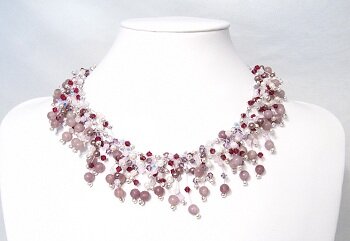|
Contact the seller in advance before paying for the order! Bone, horn and ivoryBone, horn and ivory are organic material, which means that they come from living organisms. They have been used for jewelry, ornaments and tools for thousands of years. They were probably among the first materials man shaped into something useful, like needles or knifes, since they were more malleable than stone. Needles and tools dating back to 34000 BC have been found. It probably came by naturally to use the leftovers from the animals they ate, and still does today. Highly prized for their ability to be carved, shaped, dyed and polished it was only natural that they became some of the first jewelry making materials.
Besides Pearls, Amber and Jet, there are several organic materials used to make jewelry. There are coral, wood, nuts, seeds, dinosaur eggs, only to mention a few. From the animal part of organic materials there are claws, fangs, teeth and even hooves, but the main materials used in jewelry making are bones, horns, antlers and ivory. Although we probably would consider it a tabu, human skulls have been used for spiritual reasons by Buddhist monks in Tibet. Whether they used human remains for jewelry, I don't know, but I am sure that ancient tribes sometimes did that, especially for spiritual reasons. The ones used for beads today are mainly from cow or buffalo. Camels and sheep are also used, and believe it or not, vertebra's from snakes. The so called snake beads date original back to the 1800s and is said to have played an impact on the relationship between Africa and Europe. Deer bone is particularly strong and can be used to make bugle beads. You can find beads from this material many places in the world, but they are mainly produced in Indonesia and the Philippines. The animals are domestic and not solemnly killed for their skeletons, but for their meat, and the bones are used as a secondary source of income. So when it comes to these beads, you don't have to worry about buying something illegal or from nearly extinct animals. Animal skeleton have a spongy central portion of marrow. From this blood vessels extend into the more solid areas of the bone. You can see them as tiny dark spots, pits or lines on the surface of the object. When it is polished these anomalies can be seen clearly. If you have bought bone beads and want to dye them, you can do this with tea, coffee and even with cola. Just put them to soak for a few hours. The longer the bone is in the liquid, the darker it will get. You can bleach it with a solution of 1 part bleach and 7 parts water, and you can color it with ordinary fabric dye. Some beads that have been antiqued can emit a smoked scent. If you find this unpleasant, you can get rid of the smell by rubbing the bead with a soft cloth with fabric softener. There are lots of beautiful bone beads to get, some are heavily carved and ornamented. And, the best of all, they are absolutely legal and affordable. Ivory on the other hand is a bit more complex. Ivory: Hunting for ivory have been done for thousands of years. It has been highly priced for its lovely cream to white color which yellows gracefully with time. Like bone it is easy to carve and engrave. Covered with a smooth layer of enamel that bone lacks, ivory can be polished to a very high shine. The Roman emperor Caligula (AD 12 – 45) was so fascinated by ivory that he made a whole stable box from it, in which he put his favorite horse. He was raving mad of course, and even made the horse a senator and had it dine with him regularly.
Sadly there is no way to obtain ivory without killing the animal. Already by the fall of the roman empire, elephants were nearly extinct in northern Africa and Asia minor. And even more sadly, this raised the value on- and the desire for ivory. Today the restrictions are a bit eased to allow some trade of fresh ivory, but in general only ivory that is older than 100 years, and both age and origin can be determined is legal on the market. USA have forbidden all international export of ivory, and even eBay has banned ivory from their listings. The only legal elephant ivory beads on the market today are vintage. The increased hunt for ivory from sea mammals eventually led to strict regulations by the Department of fisheries and oceans. Some hunting for meat is allowed, and the ivory can then be used as a second resource of income. The trade with this ivory is still legal, but regulated in Canada. USA restricts imports of walrus and narwhal. Also The international trade of sea mammal ivory is somewhat restricted by The Convention On The International Trade Of Endangered Species. So, ivory is banned, or? Well, not all. You can legally buy mammoth ivory. Mammoth ivory is fossilized ivory from the woolly mammoth. This means that you have ivory that is tens of thousands of years old. If you mix it with Amber, you actually have a true prehistoric jewelry around your neck. The colors of mammoth ivory range from almost white to darker earth tones, which are due to mineral absorption from the tundra soil where the animal died. They can range in color from browns, reds and even blues. Because of the limited supply of legal ivory, bone has become a very suitable substitute, at least on the jewelry front. It is a bit heavier, does not get as white, and cannot be polished as shiny as ivory. But, hey, unless you put your bone bead next to a ivory one, no body will ever see these minor differences. And the best: no animal is killed solemnly for their teeth. Antlers and horn:
How to take care of your bone, ivory and horn jewelry: They stain easily so keep them away from perfume and hairspray and other substances that may stain them in any way. Natural oils from your skin may actually also stain them, so wiping them with a soft cloth after use, may be wise. Return from Bone, Horn And Ivory to It's All About Jewelry Beads Leave a comment ,I would love to hear your opinion on this page. Good or bad, it will help me making this Site better. Comments from other visitorsClick below to see contributions from other visitors to this page... Vintage bone jewelry - identification |








